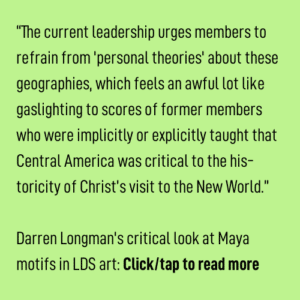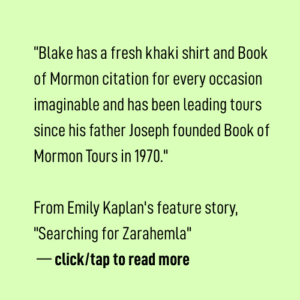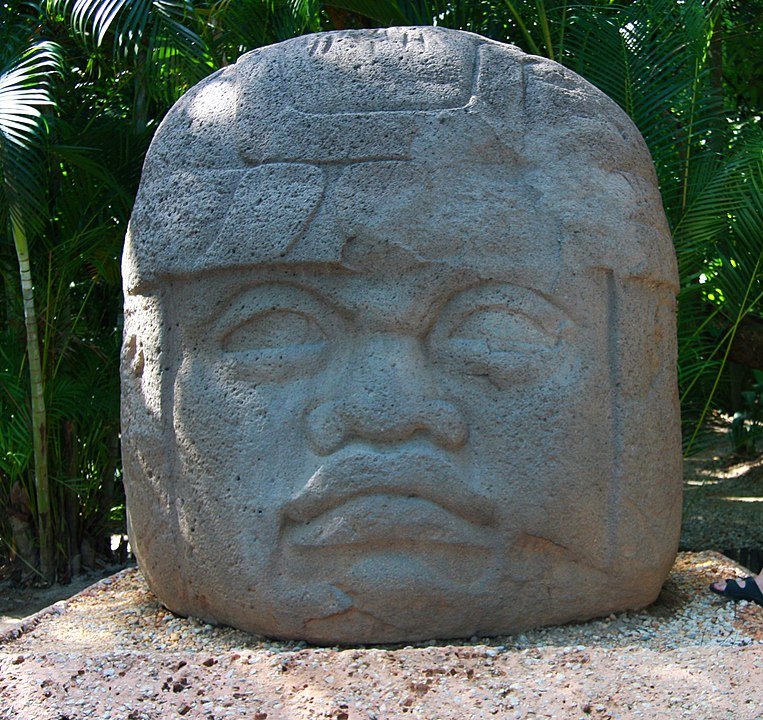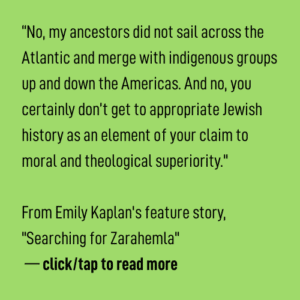Catherine Nuckols-Wilde
no. 8, The Road Trip Issue
Autumn 2022
For Mormons, the twin concepts of testimony (declaring a truth to other people) and personal revelation (a communication from god to man) present an interesting paradox. Although Mormons are generally expected to adhere to the church’s views and perspectives, each individual is also encouraged to receive personal revelation for their life from God, in much the same way that the church’s founder Joseph Smith did — although these personal revelations are still expected to adhere to church teachings and reinforce accepted doctrine. Since the Church of Jesus Christ of Latter-day Saints (or COJCOLDS) has staunchly maintained a position of neutrality regarding Book of Mormon geography (with the exception of Joseph Smith’s early belief that it occurred in Central America… or the Midwest), members of the church have, until recently, been allowed to decide for themselves where they believe the Book of Mormon took place.

This means that there are as many theories as there are members interested in the theories, and it means each person’s theory is as valid as the next as long as they believe they have received confirmation from God — a key Mormon tenet is that testimony is irrefutable if it has divine confirmation. Unfortunately, many of these personal theories distort archaeological evidence, particularly those from the 20th century.
* * *
The most frequently-studied era for serious students of Book of Mormon geography and history is the Mesoamerican Preclassic Period (1800-250 BCE), the period that aligns with most of the stories recorded in the Book of Mormon and therefore the best candidate for archaeological data that would support the book’s historicity. This explains the special particular geographic focus of the New World Archaeological Foundation (NWAF): originally founded and funded in the mid-20th century by the Church at the petition of Thomas Stuart Ferguson, a Mormon lawyer who believed that archaeological confirmation of the Book of Mormon was inevitable with the right excavation in the right place, it has become the leading institute for studies of Preclassic Mesoamerica, particularly in the Gulf Coast and along the Pacific Coast of Guatemala and Mexico. (Ferguson was eventually disillusioned by the lack of evidence and renounced his faith in Mormonism and in God entirely).
NWAF has produced quality scholarship by researchers within and affiliated with the institution. But some archaeologists also recount stories of data being occasionally manipulated to fit a Book of Mormon narrative; I spoke with one who described the skewing of settlement pattern data for an Olmec site so that it more closely mirrored settlement patterns on the Pacific Coast, thus aligning with Jaredite and Nephite settlements described in the Book of Mormon. Many Mormon scholars have a mandate that their research be “faith-promoting,” which sometimes translates to an inclination to prove the historicity of ancient scripture rather than the pursuit of truth.

Independent Mormon scholars also use archaeological research to promote their own theories. The first and most obvious example is the Allen family, headed by Book of Mormon Tours founder Joseph Allen, who received a Ph.D. in Mesoamerican studies that should have prevented some of the more obvious misinterpretations. Another key Mormon figure in contemporary Mesoamerican archaeology is Richard Hansen, who heads the El Mirador Basin Project in Guatemala. He is a polemic and controversial figure in academic circles, first for his highly-criticized (but lucrative) consulting with Mel Gibson on the film Apocalypto, and more recently for his endeavors to create a U.S.-funded “real live Disneyland” park in the Guatemalan jungle to increase tourism and funding for excavations at the site. His efforts have been resoundingly criticized by scholars and indigenous groups (as in this open letter from the group Maya Tujaal), who see a clear link between his religious affiliation and his colonialist endeavors.
Book of Mormon scholarship, much of it by armchair archaeologists, has forever altered the way that some Preclassic works of Maya art are perceived. For many Mormons, Stela 5 from the site of Izapa is an ancient representation of a cherished passage of scripture — the prophet Lehi’s vision of the Tree of Life as described in 1 Nephi 8, 11:1-9. Even today, a Google search for “Izapa Stela 5” returns dozens of results devoted to proving the geographic location of the Book of Mormon. (The monument doesn’t have any inscriptions so there’s no clear way to confirm or refute this interpretation, though the concept of a sacred tree at the center of the world is hardly unique to Mormonism.) Other Preclassic monuments have been similarly co-opted: the colossal Olmec heads believed to represent ancient Jaredite kings, a stone carving of a merchant from La Venta theorized to be the wandering Jaredite prophet-king Coriantumr, and the La Mojarra stela with unknown engravings thought to be an inscription interpreted by the Nephite king in 1 Omni 15.

Somewhat bewilderingly, these misinterpretations of Maya art extend into the Classic period (250-900 CE), a time period largely uncovered by the Book of Mormon. Especially egregious are the misinterpretations of Late Classic monuments with hieroglyphic inscriptions. Monuments at the site of Palenque are used to reinforce the theory that Chan Balaam (written today as Kan Bahlam) was the Jaredite king Kish. This interpretation, which could have been considered an “alternative interpretation” a century ago, can today only be considered willful ignorance, given that Palenque’s hieroglyphic texts provide the figure’s name and the time period during which he ruled: the 8th century CE, easily 1500 years after the time when Kish is believed to have lived. To assert this theory, one has to knowingly set aside Kan Bahlam’s documented name and history— an ironic thing to do in 2022, when Mormons and non-Mormons alike are being asked to refer to the church by its own documented name.

During an internship for Brigham Young University’s Museum of Peoples and Cultures, I was tasked with updating placard information for a replica of a tablet at Palenque, also from the 8th century. My supervisor expressed his enthusiasm for the monument and his personal belief that the scene represented a celestial moment in which God the Father bestowed the priesthood upon Jesus Christ. Besides the fact that this account appears nowhere in Mormon theology, every detail of the monument (except the presence of two male figures) refutes this interpretation: a cursory reading of any book on Maya iconography would identify it as a traditional bloodletting, in which the participant pierces his genitals with a stingray spine and gathers the resulting droplets of blood on bark paper to be burned in a ceremonial dish. Additionally, the scene is flanked by hieroglyphic inscriptions that describe the purpose and content of the ritual portrayed. This monument, like many others, tells its own tale. To superimpose a different narrative suggests either that the original is inaccurate, or that the people writing it did not know their own story.
* * *
Most of the Mormon and Mormon-adjacent scholars I’ve met in recent years succeed in recognizing their biases, and keep them from influencing their work. Even the COJCOLDS has begun to distance itself from previous theories — it no longer funds the NWAF. However, in a world where pseudo-archaeological television shows traffic in unsubstantiated and sensationalized claims for public consumption (like Netflix’s recent Ancient Apocalypse), it is even more important to acknowledge the colonialist and racist motives underlying any theory that suggests the accomplishments of the “New World” belong to anyone other than the indigenous cultures that originally inhabited it. And the best way to correct the record is to respect the documented stories of those who lived them.
Catherine Nuckols-Wilde is an art historian, epigrapher, and Latin Americanist working on a joint Ph.D. in Art History and Latin American Studies at Tulane University. She specializes in the art and writing of the Classic Maya.

More great reading
from Pipe Wrench no. 8
Searching for Zarahemla
Journalist Emily Fox Kaplan recounts an epic Mormon road trip across Mesoamerica. How many ways are there to tell a story? And how do we know what’s true?
In Unto the New Jerusalem
Art historian (and ex-Mormon) Darren Longman takes a critical look at Ancient Mesoamerica’s (mis)representation in Mormon visual culture.
Creating Visual Syncretism
Axel Rangel García incorporated layers of symbolism into his illustrations for our feature story, and you can explore them one by one.
